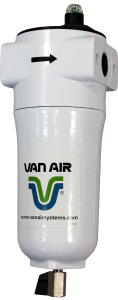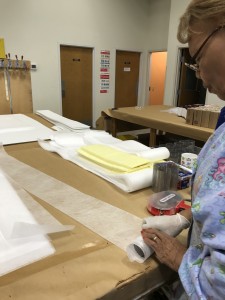Particulate and Coalescing Compressed Air and Natural Gas Filters and Elements – Know the difference
Van Air Systems Filters and Elements
Considered the fourth utility alongside water, electricity and natural gas, compressed air is utilized in nearly every manufacturing process. With such a prominent role, it’s imperative that this utility maintain its absence of moisture and other contaminants. Proper adherence to this end, promotes the avoidance of excessive downtime, elevated operating costs and unnecessary pressure drop. Properly maintained filtration is paramount to any air operated process and Van Air Systems has you covered.
Van Air Systems manufactures cast aluminum and ASME coded filters in a variety of element grades and flows to cover all your needs. Van Air F200 cast filters are built for flows from 15cfm through 1600cfm. A Lifetime warranty accompanies this line and ensures that bowls and heads of these products provide unrivaled protection. Van Air also offers its F101 ASME coded filter line for both Air and Gas and are built for flows from 500cfm through 5000cfm. Both lines are built for longevity and unlike most competitors, Van Air ensures that their corresponding elements will not crush, fall apart and migrate downstream.
Van Air hand builds its supporting coalescing and particulate elements for both its F200 and F101 line. These handmade elements are built to last, with reinforced steel coils for added strength and reliability. Element grades range from 25micron, all the way down to .01 micron. A brief differentiation of these two elements follow.
Coalescing Elements:
Coalescing elements function as a separation tool for liquids and are commonly mistaken for filters. These elements direct compressed air flow from the inside of the element to the outside. Oil, water aerosols and fine droplets run together (coalesce) to form larger, heavier droplets that are gravitationally drained away. Once the liquid is removed from the system, it must be prevented from re-entering the clean air. While these elements can be used in a variety of applications, they are vital in protecting compressed air dryers to preserve the integrity and cleanliness of the material or components used in the process.
Particulate Elements:
Particulate elements protect downstream air and processes from small pieces of solid material such as dust, dirt and or pollen from the ambient air, as well as loose metal particles that can be caused by pipe corrosion. Particulate filters dictate an outside to inside flow. Particulates hit the outside of the filter and are trapped, as the scrubbed compressed air travels through the element to the inside and downstream. Depending on the sensitivity of your application, contact with particles can be damaging, therefore causing delays in production and quality control issues, not to mention potentially unsatisfied customers. Particulate elements are often placed after a compressed air dryer, to prevent a variety of desiccants, particulates, rust scale and a multitude of other contaminants inhaled by the compressor to migrate downstream.
It is important to note that as important as filters and elements are in every compressed air process, they are not intended to replace an appropriate compressed air dryer. While a coalescing element can remove vapor and oil particles, the exiting compressed air is fully saturated with moisture, and will continue to condense this moisture throughout the compressor loop. Therefore, an appropriately selected and sized compressed air dryer ensures that your filter and separator components complete your air treatment system. With this said, Van Air Systems fully stands behind their warranted filters 100% and have the right size and grade to protect your facility and processes.
Click here to watch our video showcasing the differences between coalescing and particulate filters & elements. Filter Difference Video


